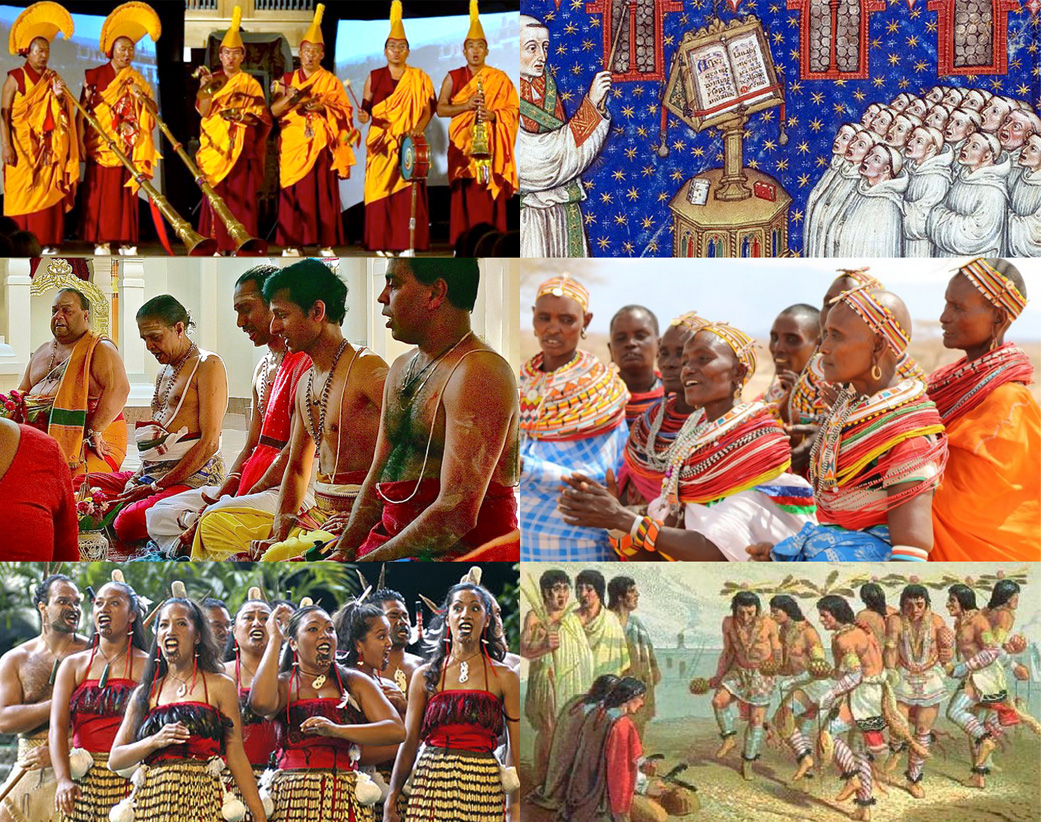chanting – an ancient technique of devotion and trance
Chanting means repeating certain words or sentences for a long time evoking a solemn, elated or ecstatic mood in the chanter and the listener . Various components like rhythm, melody, the sound of the words and the meaning of the words are harmonizing for your mind and body. It has been practiced allover the world by many tribal and religious groups for spiritual purposes, but also in war and fighting participants and supporters are using the same techniques to strengthen their courage.

Clockwise: Tibetan monks – Christian monks in medieval times – Samburu people in Kenia – American indigenous people – Maori women from New Zealand – Brahmins from India. (Photographs retrieved from various sources from the internet in July 2016)
kirtan – a special style of chanting
As a spiritual practice chanting has been used in many traditions. Perhaps the most elaborate variations have emanated from the Hindu traditions, still practised throughout India today as Kirtan. Kirtan is a Sanskrit word meaning “mentioning, praising, celebrating”. It is a way of expressing your devotion to the Divine with song and chanting originating from Hindu and Buddhist traditions. The words can be simply the repetition of the name of god, a prayer or a mantra. The words are sung and mostly accompanied by music. Typical instruments are Indian harmonium, guitar, tabla, drums or cymbals. Often Kirtan is performed as “call and response”: the leader(s) sing(s) a short phrase, which is repeated by the audience, but the tunes can also be sung together. No singing skills are required as prerequisites. Anybody willing to express their devotion and love through their voice is capable of participating.
Especially when alternating with periods of silence kirtan invokes and intensifies states of stillness, peacefulness and meditation. Here are a few examples:
om mani peme hung
The Sanskrit mantra Om Mani Padme Hum (and it’s Tibetan variation Om Mani Peme Hung, meaning the same ) is perhaps the most famous and widespread mantra – here recorded life in Kirtan by Anugraha, Mahendra and friends with a traditional tune. It is the mantra of Avalokiteshvara, the Buddha of compassion. It has been first mentioned in an ancient Indian text, called the Karandavyuha Sutra, but we don’t know, who created it originally. We also don’t know the initially intended meaning. We know the meaning of the words:
OM – – – – – – – – the primordial sound out of which everything arises
MANI – – – – – – – jewel
PADMA – – – – – lotus
HUM – – – – – – – the sound into which everything dissolves
The grammatical form leaves space for various interpretations and it remains a koan in what kind of relationship these four words are. As Avalokiteshvara’s compassion is focused on the awakening of all sentient beings the mantra is predominantly seen as a prayer for awakening. Out of the OM, the infinite formlessness, the jewel and the lotus are born and we address them “Oh jewel! Oh lotus!”. Both are symbols for transformation and clarity. The jewel as the most refined crystallization of the earth and the lotus as a living beauty rising from the mud. This prayer is multiplied through the inscriptions on millions of prayer flags, prayer mills and mani stones in the Buddhist countries.
shree ram
“Shree Ram Jay Ram Jay Jay Ram Om” is another popular and simple form of a Sanskrit Mantra.
“Shree” is a form of reverence for a holy person, “Ram” means God, particularly Vishnu’s divine incarnation as Lord Ram, “Jay” means “hail or victory to” and “Om” is the primordial sound of existence, which is mostly opening or closing a mantra. This version is presented by Anugraha and Mahendra in Zurich.
arunachala
An example of a traditional South Indian chant sung in praise of the holy mountain Arunachala. This song was written by Ramana Maharshi, the South Indian sage, who lived at the foot of Arunachala. This rendition of Bhagwan Sri Ramana Maharshi’s Aksharamanamalai hymn is performed by the Ramananjali group. Aksharamanamalai literally means “Marital Garden of Letters”. It contains 108 stanzas, each one relating to one of the 108 names of Shiva.
